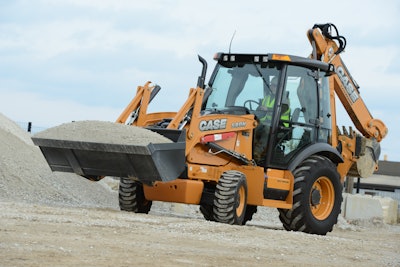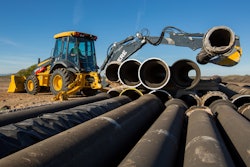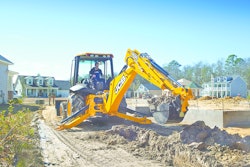
Seat-mounted or fully adjustable control pods with critical machine functions located at your fingertips are the norm for the current crop of backhoe-loaders. Yet some manufacturers have pushed technology even further, in part to help offset the cost of Tier 4 emissions technology.
Ergonomic design has become a major focus. “The integration of the operator interface with improved ergonomic design into the machine controls has evolved substantially over the past decade,” says Brian Hennings, backhoe-loaders and tractor-loaders marketing manager, John Deere Construction & Forestry.
Controls that adapt to operator preferences translate into more potential profit for the owner. “Features like in-cab pattern changers mean owners can keep everyone working efficiently no matter which control pattern they prefer,” says Kevin Hershberger, senior market professional, backhoe-loaders, Caterpillar. “It’s increasingly hard to find good operators, so it becomes important to have comfortable, controllable machines with systems and controls to optimize performance regardless of skill level. Well-tuned hydraulic systems and integration of all components in the system ensure that we deliver machines ready for the wide range of operators and applications they will encounter.”
Automation also boosts productivity. “Automation makes it easier for the operator who is doing repetitive tasks 10 hours a day,” says Rafael Nunez, JCB’s backhoe-loader product manager. JCB currently offers seven automation features in an Automate package, which includes AutoCHECK, AutoTHROTTLE, AutoDRIVE, AutoIDLE, AutoSRS (boom suspension), AutoSTABILIZERS and AutoBOOMLOCK. These features are standard on every Tier 4 Final Super model, with the exception of automatic stabilizers and automatic boom lock on manual control machines.
Automation features provide an incentive for customers to upgrade to more expensive Tier 4 models. “We added these seven features that together make a compelling reason to purchase JCB backhoes,” says Nunez. “You will continue to see more automated features in our cab.”
Case Construction has also concentrated on simplified use. “We’ve built controls/features into the machine that give operators added control and functionality without having to think much about it, essentially improving performance through simplification,” says Katie Pullen, brand marketing manager.
Efficiency gains have also been made in the hydraulic system. “The continued evolution of hydraulics and electronics have allowed for the development of operating modes and settings that let operators be more efficient — using only as much power as needed to complete the work,” says Pullen.
She adds, “More features, bells and whistles have become standard in recent years. Backhoes are extremely popular with the owner/operator community. As it’s ultimately the operator making that buying decision, they know what they want and they know what they like. Manufacturers have worked to make more of those features standard as they experienced high take rates as options.”
Pilot and EH controls Enable Greater Functionality
Pilot and electrohydraulic (EH) controls make many advanced features possible.
Caterpillar has used pilot controls on its backhoe-loaders since 2001. A lot has changed since then. “We’ve put more functionality into the joysticks, both loader and backhoe, and we’ve given operators more ability to optimize settings for various applications,” says Hershberger. “Controllability has improved for finishing applications, while maintaining hydraulic response and improving productivity. Additional advancements like electronic pump control and engine power management techniques have helped us deliver more work output while burning less fuel.
“A new control pod system, standard with all pilot controls, enables fore-aft adjustment on all machines and an additional width adjustment on the 420/430 joystick control towers,” he adds. “Controls can be positioned anywhere within the full range of pod motion, which is operated by a floor pedal, similar to the Cat tilt steering column.”
Case also uses pilot controls. “Our pilot controls are true pilot controls, not electrohydraulic, which gives the operator more feel,” says Pullen. They feature unlimited adjustments fore/aft, tilt in/out and full surface adjustable wrist rests. “We also have proportional hydraulic control on the front loader lever that the operator can change. The standard setting is set up for proportional up and down. If they need a detent, they can lock it in so they have a detented switch without worrying about accidentally putting it into detent if you have an attachment that is not meant to be detented.”
EH controls also allow additional flexibility. “John Deere has been working with EH controls for years and has incorporated this technology in both front loader and backhoe auxiliary hydraulics,” says Hennings. “Many customers appreciate the user-friendly value EH controls provide when used in the many different attachments available in both loader and backhoe applications.”
JCB offers a range of control options, from the manual “wobble stick” control to excavator-type controls. “On our Supers you have a choice of Easy Controls (EC) and Advanced Easy Controls (AEC),” says Nunez. “Easy Controls use an open-center valve block, which provides full flow to the valve block. For operators, these pilot controls are going to feel very similar to a manual control machine.
“The Advanced Easy Controls are more like excavator controls, which use a flow-sharing valve block,” he continues. “A flow-sharing valve block is going to automatically share the flow. So if you pull on the boom and the dipper with equal amounts of force, they will come in evenly. With Easy Controls, you would have to meter the boom and the dipper yourself to make it do a straight cut.”
Control Layout Simplifies Operation
Manufacturers have taken different approaches to simplify operation.
Caterpillar offers different control options on its F2 backhoe-loaders based on the model. “Pilot control features vary according to machine model,” notes Hershberger. “For example, the 415F2 and 416F2 units have foot pedals to operate auxiliary functions like E-Sticks, hammers and thumbs. The more advanced 420F2 and 430F2 use joystick-mounted roller switches for aux function controls. Additional features on the 420 and 430 include programmable flow settings, and a continuous flow switch that lets you lock in a set flow rate for tools like plate compactors.”
Caterpillar’s Integrated Tool carrier (IT) versions of its 420F2 and 430F2 deliver several enhanced features. “The differential lock moves from the floor to the loader control,” says Hershberger. “Third function hydraulics to operate a multi-purpose bucket or broom are also on the loader control. Plus, we’ve added the transmission shift function. An operator can now do every function required for loader work while maintaining one hand on the steering wheel and one hand on the loader control. This significantly reduces the motion and effort involved in all loading tasks. The single-tilt versions have also been upgraded with differential lock and MP hydraulics on the loader joystick.
Caterpillar also offers four-wheel braking at the touch of a button. “The primary benefits of the Cat Brake Mode Selector switch are improved braking performance and reduced tire and driveline wear,” says Hershberger. “On typical backhoes, the operator must be in 4WD to achieve the shortest stopping distance. However, operating in 4WD when driving on roads increases tire and drivetrain wear. So the Cat system allows operators to run in 2WD, but automatically engages 4WD when the brakes are applied.”
John Deere has made significant enhancements with its new L-Series. “The L-Series includes a new ergonomic design ‘palm on top’ loader control grip that is more comfortable and easy to use,” says Hennings. “It includes added functionality including momentary MFWD and transmission quick shift for more convenient access to controls. Redesigned pilot levers provide fingertip operation of many machine functions to enable even easier operation. Also, the redesigned pilot towers have increased leg clearance when rotating from loader operation to backhoe operation.”
Case Construction has reduced steering effort with Comfort Steer. It reduces how many times an operator has to turn the steering wheel to get the tires in full turn while in first and second gear. “With this feature operators aren’t cranking their arms as much to get the machine to turn, which reduces operator fatigue and makes it easier to maneuver the backhoe,” says Pullen.
Case Construction also allows customers to customize the feel of forward-to-reverse transitions to their preference with its standard SmartClutch. It can be set to smooth, moderate or aggressive. This provides some practical benefits in applications that require frequent changes in direction. “Snow removal is a good example — you push forward and then you shift to go into reverse, over and over,” says Pullen. “That’s a lot of back-and-forth motion. Having it set on aggressive may be too rough on the operators, so they can switch it to smooth for a softer transition.
“Conversely, on jobsites with a lot of obstacles, the operator will want it set more aggressively so that the machine stops and changes directions immediately,” she points out. “The differences are minimal, but noticeable enough that it will make a difference in how the machine changes direction, and how the operator feels behind the controls.”
Case offers a PowerLift button, which increases the lifting capacity of the backhoe with the push of a button. “This feature also decreases the rpms of the engine to ensure smooth lifting and quieter operation,” says Pullen. “This feature can give a backhoe lifting capabilities comparable to a 7-ton excavator. PowerLift also allows the hydraulic system to be more efficient by increasing hydraulic power on demand vs. having it at excessive power at all times.”
Mode settings also allow the operator to tailor the settings of Case backhoes. “With our auxiliary hydraulics, the unidirectional setup features a control setting dial that allows operators to choose one of six preset flows for specific attachments. This gets them more in the range of where they need to be without having to go into the machine and dial down pumps,” says Pullen.
Other features simplifying operation include a diff lock mounted on the loader handle for easy access, a shake feature on the stabilizers to get material off and an integrated quick coupler that allows operators to change attachments without leaving the cab or changing machine performance.
John Deere offers a coupler, as well. “We provide the customer with an option for a front hydraulic loader coupler on all L-Series models,” says Hennings. This fills the gap left open by the discontinued Total Machine Control (TMC) models.
JCB offers an autoshift option on its six-speed transmission for roading applications. Gears one through three shift manually since these are working gears. “As soon as you hit the fourth gear, there is an A on the steering column and it automatically takes care of shifting between fourth, fifth and sixth,” says Nunez. “If you get that option, you also get a kickdown switch that allows you to kick down one gear to get more torque when you are pushing into a pile.”
Hydraulic System Advancements Increase Efficiency
Optimized work modes and load-sensing piston pumps are just a couple examples of technologies that result in increased hydraulic system efficiency.
John Deere recently expanded its hydraulic system offerings. “The L-Series includes an additional model that offers pressure-compensating, load-sensing (PCLS) hydraulics,” says Hennings. “The new 310SL HL provides operators with efficient, smooth control and functionality at a wider range of engine rpms. The advanced onboard monitor also provides customers with quick troubleshooting and maximum uptime.”
Caterpillar uses load-sensing, variable-displacement piston pumps on its backhoes, which provide full lift and dig forces through the entire engine speed range. This allows many tasks to be completed at low idle, reducing the noise level and improving communication between the operator and the ground crew.
JCB touts the load-sensing piston pumps as one of the most important advancements in the past five years. “Adding axial piston pumps has been a huge driver behind our fuel efficiency and productivity gains,” says Nunez. “The wear and tear you get on a fixed gear machine is different than what you get on an axial piston pump because it is load sensing. It gives you better component life because your pumps are not working all of the time, depending upon your engine rpm.”
Case Construction has also made it easier to control the swing of the backhoe. ProControl is a swing dampening system integrated into the backhoes that eliminates rebound, providing faster cycle times, less wear on components, greater operator precision and less fatigue. It is standard technology on all Case backhoes with the exception of the new Case 580N EP, which offers it as an option.
“It does affect the feel of the backhoe — it feels like more of a natural extension of the operator,” says Pullen. “Our engineers spent hours watching backhoe operation and noticed that one of the major drains on productivity was the effort an operator took to reposition the bucket after swinging it back into place.” A natural drift that took place required operators to compensate and reposition. “With ProControl, we were able to eliminate that rebound.”
JCB offers a similar feature called Anti-bounce. “When you are swinging it reduces the delay between the time you stop swinging and the time the machine stops,” says Nunez.





![[Video] John Deere 310SL HL Backhoe-loader Does Heavy Lifting in Atlanta](https://img.forconstructionpros.com/files/base/acbm/fcp/image/2015/12/default.566afed2d665d.png?auto=format%2Ccompress&fit=crop&h=167&q=70&w=250)














